Sourdough French toast is the kind of breakfast that instantly makes a lazy morning feel like a treat. There’s something nostalgic and cozy about it—maybe it’s the crispy edges, maybe it’s the soft, custardy center, or maybe it’s just how the tang of sourdough bread plays off the sweetness of syrup. Either way, if you’ve never tried making French toast with sourdough, you’re in for something special.
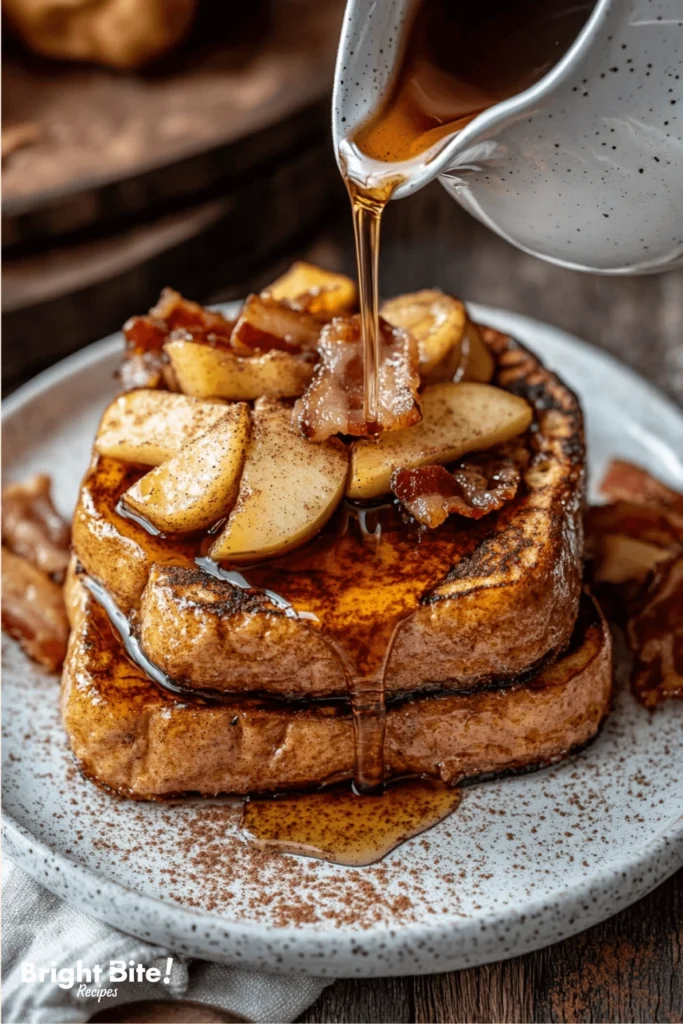
Most people think of plain sandwich bread when it comes to French toast. But switching to sourdough completely changes the game. It has a stronger structure, so it holds up better when soaked in the egg mixture. That chewiness and subtle sour flavor? It turns every bite into a perfect balance of texture and taste.
What makes sourdough french toast even more appealing is how easy it is to adapt. You can go classic with a dusting of powdered sugar and maple syrup or dress it up with berries, whipped cream, or even a little savory twist. It’s a fantastic way to use up day-old sourdough, reduce waste, and whip up something that feels far more indulgent than it is.
Whether you’re making brunch for a crowd or treating yourself to something better than cereal, sourdough french toast belongs in your rotation. In this post, we’ll cover everything you need to know—from ingredients and instructions to pro tips and serving ideas. Let’s get into it.
Table of Contents
Why You’ll Love This Recipe
This sourdough french toast recipe doesn’t just taste great—it’s got everything you want from a brunch staple, plus a little extra character thanks to the bread. Here’s what sets it apart:
- Flavor Depth: The mild tang of sourdough gives this dish a depth that regular white bread just can’t deliver. Combined with the creamy custard base and a hint of cinnamon, the taste hits every note.
- Texture Perfection: With its slightly crusty exterior and tender middle, sourdough creates that ideal contrast in every slice. It soaks up the egg mixture without falling apart or turning soggy.
- Versatile for Toppings: Want to go sweet? Fresh fruit, maple syrup, or a dusting of cinnamon sugar. Feeling savory? Try bacon, eggs, or a drizzle of hot honey. It all works.
- Great for Leftover Bread: Slightly stale sourdough is actually preferred here. It’s more absorbent, and this recipe is a great way to reduce waste.
- Easy to Scale: Whether you’re making breakfast for one or ten, the recipe scales easily without sacrificing quality.
This isn’t just another breakfast—it’s one you’ll start craving regularly.
Detailed Ingredients and Instructions
Sourdough French toast starts with just a few basic ingredients, but the quality of each one makes a big difference. Here’s how to break it down and get the best results.
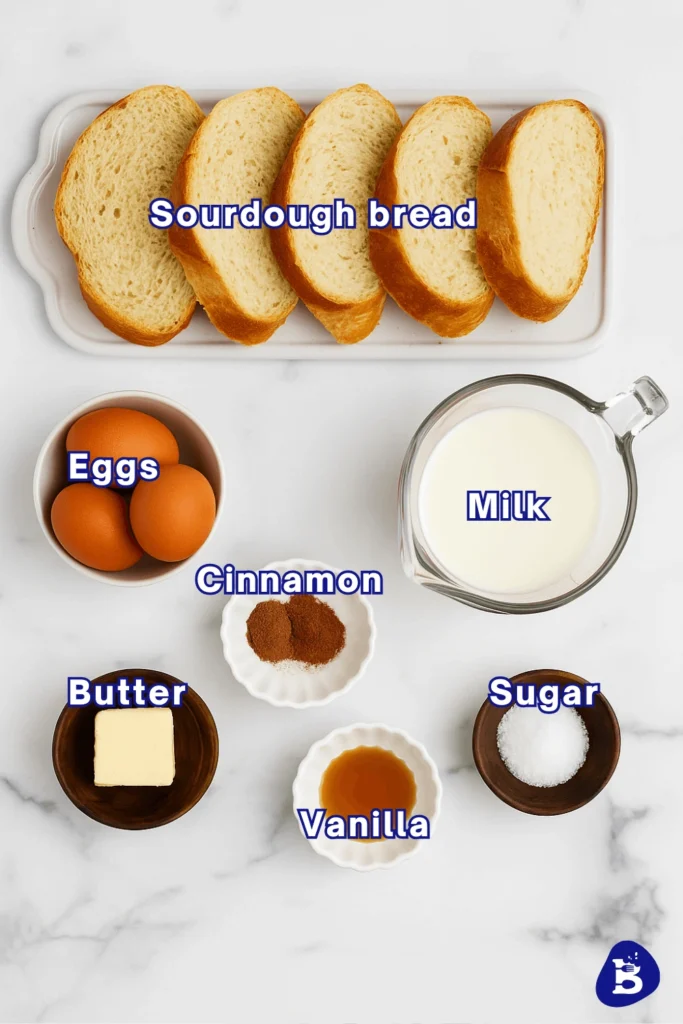
The Bread: Choose a sourdough loaf with a hearty crust and a soft, slightly open crumb. If it’s homemade or from an artisan bakery, it’s even better. Avoid pre-sliced varieties—they’re often too thin and won’t soak up enough custard.
Let the bread sit out overnight if possible. A slightly dried-out slice absorbs the custard better than fresh, fluffy bread. Aim for slices about three-quarters of an inch thick. Too thin, and they’ll fall apart. Too thick, and the center won’t cook properly.
The Custard Mixture: The base of your French toast custard should be a simple blend: eggs, milk, vanilla, and a touch of cinnamon or nutmeg. Some people add sugar, but the bread and toppings usually bring plenty of sweetness. Whole milk or half-and-half makes for a richer finish, but you can use dairy alternatives if needed.
Whisk everything together in a shallow bowl or pie plate. This gives you room to soak each slice evenly without making a mess.
Soaking the Bread
Give each slice a good soak—at least 15 seconds per side. You want it saturated but not falling apart. If your bread is very dry, let it sit a little longer.
Cooking It Right
Use a skillet or griddle over medium heat. Melt a bit of butter before adding the slices. Don’t crowd the pan, and give each piece room to cook. Let it sizzle gently—too hot, and the outside will burn before the inside cooks.
Cook for about 3 minutes per side or until golden brown. You’ll know it’s done when the outside has a crisp finish, and the middle is custardy but set.
Serving
Serve immediately, or keep warm in a low oven if you’re making multiple batches. Add toppings right before serving to maintain the texture.
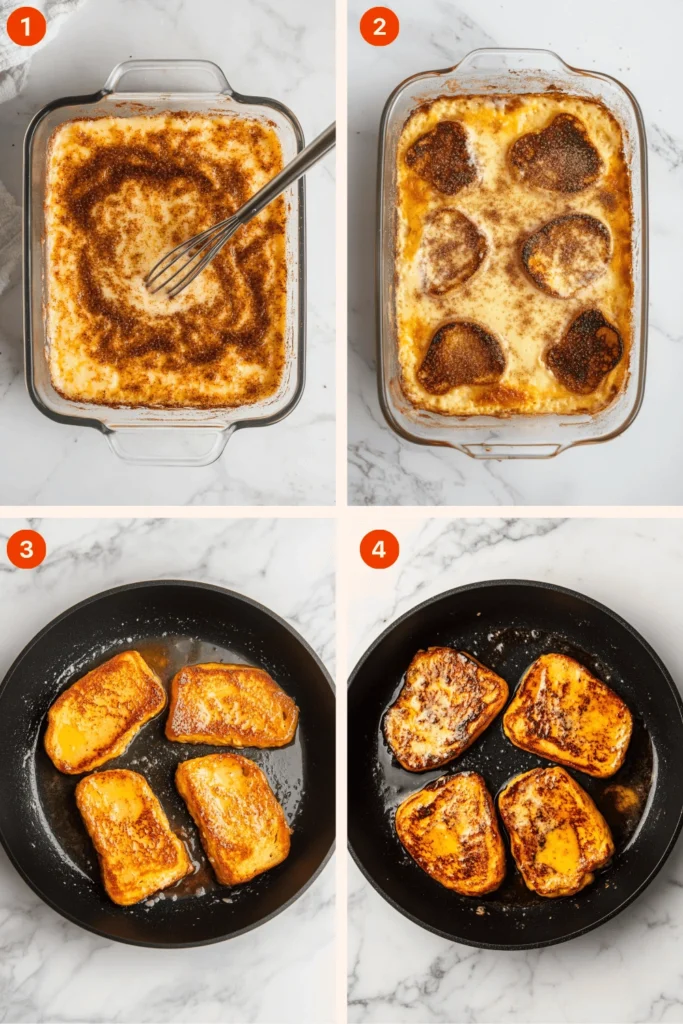
Tips, Variations, and Storage Options
This recipe is super adaptable. Whether you’re making it for kids, brunch guests, or just yourself, there are plenty of ways to switch things up or make it ahead of time.
Pro Tips for Perfect Results
- Dry Bread = Better Texture: Slightly stale bread is your friend. It holds up better during soaking and gives a crispier finish.
- Use Real Butter: Butter brings flavor and browns beautifully. Don’t substitute with margarine unless necessary.
- Watch the Heat: Medium to medium-low heat is ideal. Rushing the process can burn the outside before the inside sets.
- Let It Rest Before Serving: A quick minute off the heat helps the custard settle and prevents sogginess.
Fun Variations
- Citrus Zest: Add orange or lemon zest to the custard for a fresh, bright twist.
- Savory Version: Skip the sugar and cinnamon. Add salt, pepper, herbs, and maybe some shredded cheese for a savory brunch version. Top with avocado or poached eggs.
- Stuffed French Toast: Spread cream cheese, Nutella, or jam between two slices before soaking. It’s a bit indulgent, but that’s the point.
- Vegan Option: Use thick plant milk like oats or almonds and replace eggs with a flaxseed mixture. Use vegan butter or oil for cooking.
Make-Ahead and Storage Tips
- Make-Ahead Custard: You can prep the custard mix the night before and store it in the fridge. Just stir it well before using it.
- Freeze Slices: Cook extra slices, cool them, then freeze with parchment paper between each one. Reheat in a toaster or oven.
- Fridge Storage: Store leftovers in an airtight container for up to two days. Reheat in a skillet for the best texture, or microwave if you’re in a hurry.
This flexibility means sourdough french toast can be a quick weekday breakfast or the centerpiece of a weekend brunch. Either way, you can make it work for your schedule.
Equipment Needed
You don’t need much to make sourdough French toast, but having the right tools makes the process smoother.
- Sharp Bread Knife: This is used to slice the sourdough evenly without crushing it.
- Mixing Bowl: A shallow dish or pie plate is ideal for whisking and soaking.
- Whisk or Fork: This is used to blend the custard ingredients.
- Nonstick Skillet or Griddle: Helps cook the toast evenly and avoids sticking.
- Spatula: This is used to flip each slice without tearing it.
That’s really it—no fancy appliances are required. Just solid, basic tools that do their job well.
Related Recipes
If you love sourdough french toast, chances are you’ll enjoy other cozy, satisfying breakfasts. Here are a few ideas to try next:
- Brioche French Toast: For something a little richer, brioche offers an ultra-soft texture and buttery flavor that soaks up custard beautifully.
- Overnight Baked French Toast: Perfect for holidays or brunch parties. You prep everything the night before and just bake in the morning. Works great with sourdough, too.
- Sourdough Pancakes: Got an extra sourdough starter? Whip up some tangy, fluffy pancakes that balance sweet and sour perfectly.
- Savory Bread Pudding: A creative way to use leftover bread. Eggs, cheese, herbs, and whatever veggies or meats you have on hand come together in a comforting, custardy bake.
Each of these plays on the same comfort-food feeling that makes sourdough french toast so appealing—simple ingredients, satisfying flavors, and a homemade touch.
Pairing/Serving Suggestions
Sourdough french toast is super versatile when it comes to what you serve it with. Here are some easy pairing ideas that’ll round out your plate.
For a Classic Breakfast
- Bacon or Sausage: The saltiness balances the sweetness of the toast.
- Fresh Fruit: Berries, sliced bananas, or sautéed apples are all great options.
- Maple Syrup: Warm up slightly for the best texture and flavor.
For a Fancier Brunch
- Whipped Cream or Mascarpone: Light, creamy toppings that don’t overpower the dish.
- Fruit Compote: Strawberries, blueberries, or peaches simmered down with a bit of sugar make a delicious topping.
- Mimosas or Coffee Cocktails: Add a little sparkle to your brunch.
Savory Twists
- Poached Eggs: Especially if you go the savory route with herbs and cheese.
- Hot Honey: Adds heat and sweetness in one drizzle.
- Herbed Yogurt or Labneh: A creamy, tangy contrast to balance the richness of the toast.
Mix and match based on what you’re craving. This dish is flexible enough to handle whatever direction you take it in.
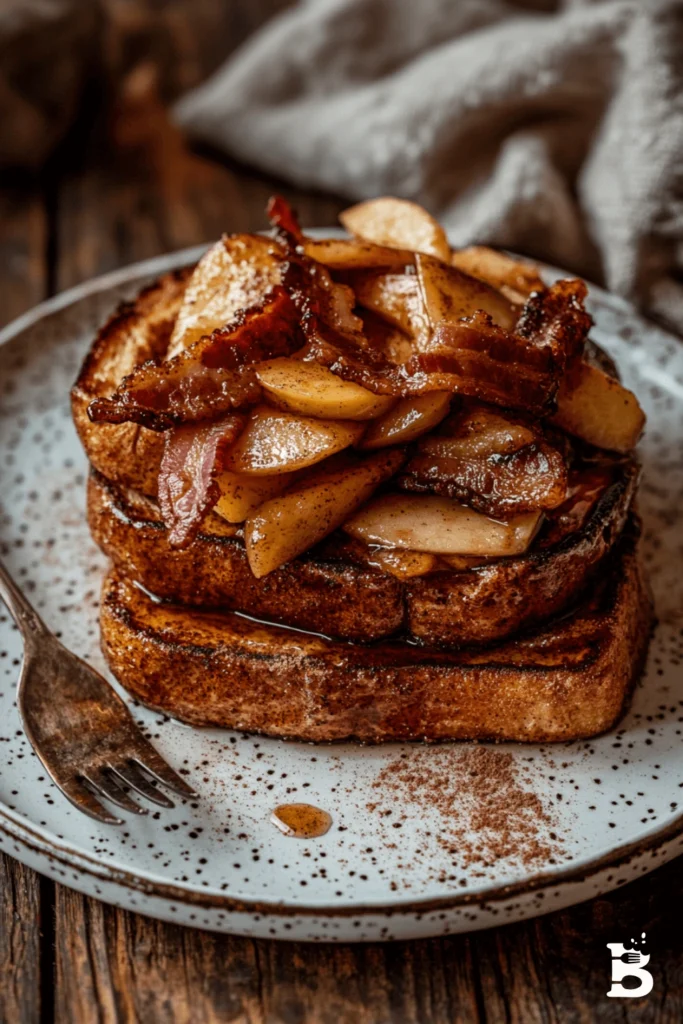
Frequently Asked Questions
People often have questions when switching to sourdough for French toast, especially if they’ve only made it with standard white bread before. Here are some of the most common ones, answered simply.
Can I use fresh sourdough bread?
Technically, yes—but older bread works better. Fresh bread can get too soft and fall apart when soaked. Letting it sit out uncovered overnight helps dry it out just enough to hold up during cooking.
What kind of sourdough is best?
Go with a traditional, crusty sourdough loaf. Avoid sourdough sandwich bread or anything pre-sliced—it’s usually too thin. Look for loaves with a tight crumb (not too many giant holes) so the custard soaks in evenly.
Can I use non-dairy milk?
Absolutely. Almond, oat, soy, or coconut milk all work. Just choose unsweetened versions unless you want added sweetness in your base.
Is sourdough french toast healthier?
It depends on how you define “healthier,” but sourdough does have some benefits. It’s lower on the glycemic index, often easier to digest, and naturally fermented. Plus, using simple ingredients lets you control the sugar and fat content.
Can I make it in the oven instead of a skillet?
Yes! Line a baking sheet with parchment, preheat to about 375°F, and bake soaked slices for 10 to 12 minutes per side. You won’t get quite the same crispy edges, but it’s a good option for batch cooking.
Why does my French toast come out soggy?
Too much soaking time or bread that’s too soft can cause sogginess. Also, cooking over low heat without enough time to brown and set the custard will leave it undercooked. Medium heat and the right pan size help avoid this.
Can I freeze it?
Yes, and it freezes really well. Let it cool completely, then layer it with parchment between slices and seal it in a freezer-safe bag. Reheat in a toaster oven for a quick breakfast later.
These FAQs cover most of the bumps you might hit your first few times. Once you get the hang of it, it becomes second nature.
Nutrition Information
Here’s a general idea of the nutritional breakdown per serving of sourdough French toast based on a classic recipe using whole milk, eggs, and butter.
- Calories: Around 250 to 300
- Protein: 8 to 10 grams
- Carbohydrates: 30 to 35 grams
- Fats: 10 to 14 grams
- Fiber: 1 to 2 grams
- Sugar: 4 to 6 grams (varies with toppings)
These numbers can shift depending on the size of your bread slices, the amount of custard absorbed, and the toppings you add. Using alternative milk, sweeteners, or lighter cooking fats can also change the nutritional profile.
If you’re looking to lighten it up, use thinner slices, egg whites, or dairy-free milk. If you want to bulk it up for a post-workout breakfast, add Greek yogurt or nut butter on top. It’s easy to adjust based on your dietary goals.
Seasonal and Occasion Variations
One of the great things about sourdough french toast is that it adapts well to the season or event. Whether it’s a cozy winter brunch or a summery breakfast spread, you can switch up ingredients and presentation without much effort.
Winter Holidays
- Add warm spices like clove, allspice, and nutmeg to the custard.
- Top with cranberry compote, spiced apples, or whipped cream.
- Try a splash of eggnog or gingerbread syrup in the batter for extra festiveness.
Spring and Easter
- Use lemon zest or lavender in the custard.
- Top with strawberries, blueberries, or lemon curd.
- Serve with pastel-colored fruit platters and mimosas.
Summer Brunches
- Add vanilla bean and almond extract to the custard for a fresh twist.
- Use grilled peaches, blackberries, or cherries on top.
- Serve cold-brew coffee and yogurt on the side.
Fall Flavors
- Stir a spoonful of pumpkin purée into the custard with cinnamon and nutmeg.
- Serve with sautéed apples, maple pecans, or a drizzle of caramel.
- Add a little brown sugar to the custard for a richer base.
Special Occasions
- For birthdays, try stuffed sourdough French toast with chocolate chips and bananas.
- For anniversaries, plate it fancy: powdered sugar, fruit coulis, and edible flowers.
- For Mother’s Day or Father’s Day, pair it with personalized toppings or breakfast cocktails.
Sourdough French toast may be simple, but that’s what makes it so easy to transform. Whether it’s casual or celebratory, the recipe fits right in.
My Recipe Tips
These are the real-world tips that take your sourdough french toast from good to “where has this been all my life?” You don’t need to be a chef—just a little attention to detail makes all the difference.
- Don’t Skip the Pre-Soak Rest: After soaking your bread in the custard, let it sit for a few seconds before transferring it to the pan. This gives the batter time to really settle into the bread, which helps with even cooking.
- Use Medium Heat, Not High: High heat will brown the outside way too fast and leave the inside undercooked. Medium heat allows the custard to set slowly while the outside gets golden. Be patient—low and steady wins here.
- Wipe the Pan Between Batches: After each batch, give the pan a quick wipe. Bits of egg or burnt butter can stick and leave dark spots on the next slices. A clean surface means evenly browned toast every time.
- Go for a Combination of Fats: Butter gives great flavor, but it can burn. Add a little neutral oil (like canola or avocado) to the pan along with butter to raise the smoke point and still get that rich, buttery taste.
- Let the Toast Rest Before Serving: Once the toast is out of the pan, give it a quick minute on a wire rack or plate before adding toppings. That little pause helps set the texture and keeps the crust from going soft too fast.
- Add a Pinch of Salt to the Custard: A tiny pinch of salt brings out the sweetness and balances the egg flavor. It seems small, but it makes the whole dish taste more “finished.”
- Don’t Overdo the Sugar in the Batter: If you plan to use syrup or other sweet toppings, keep the custard itself lightly sweet. You want the bread to carry the flavor, not overwhelm it.
These are the details that separate “okay” French toast from the kind people talk about. They’re simple, but they work every time.
Conclusion
Sourdough French toast is the kind of recipe that earns a permanent spot in your breakfast rotation. It’s easy enough for weekday mornings but special enough for brunch with friends. The tangy bread, rich custard, and crisp edges come together in a way that’s both comforting and a little unexpected.
You don’t need to overcomplicate it. A few slices of good bread, some pantry staples, and a hot pan—that’s all it really takes. From there, you can build it up or keep it simple. Add fresh fruit, go savory, double it for a group, or freeze extras for later. The flexibility makes it even better.
So next time you’ve got sourdough on the counter, don’t just make a sandwich. Turn it into something warm, golden, and worth slowing down for.
If you loved this recipe, be sure to check out more cozy breakfast ideas, smart kitchen tips, and real-life cooking guides. Because good food doesn’t have to be fancy—it just has to be made with care.
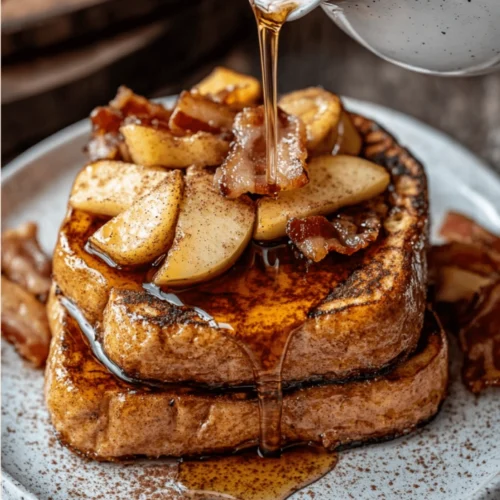
🍞 Sourdough French Toast 🍯🍓
Ingredients
- 6 slices sourdough bread day-old is best
- 3 large eggs
- 1 cup whole milk or half-and-half for richer flavor
- 1 teaspoon vanilla extract
- 1 teaspoon ground cinnamon
- 1 tablespoon sugar optional
- Pinch of salt
- 1 tablespoon butter for cooking
- Maple syrup powdered sugar, and fresh berries (for serving)
Instructions
- Make the custard: In a shallow bowl, whisk together the eggs, milk, vanilla extract, cinnamon, sugar, and salt until fully combined.
- Soak the bread: Dip each slice of sourdough into the custard, letting it soak for about 20–30 seconds on each side so it absorbs the mixture but doesn’t get soggy.
- Preheat the skillet: Heat a large skillet or griddle over medium heat and add a bit of butter.
- Cook the French toast: Place the soaked slices onto the skillet and cook for 2–3 minutes per side, or until golden brown and crisp on the outside.
- Serve: Serve warm with maple syrup, powdered sugar, and fresh berries.
